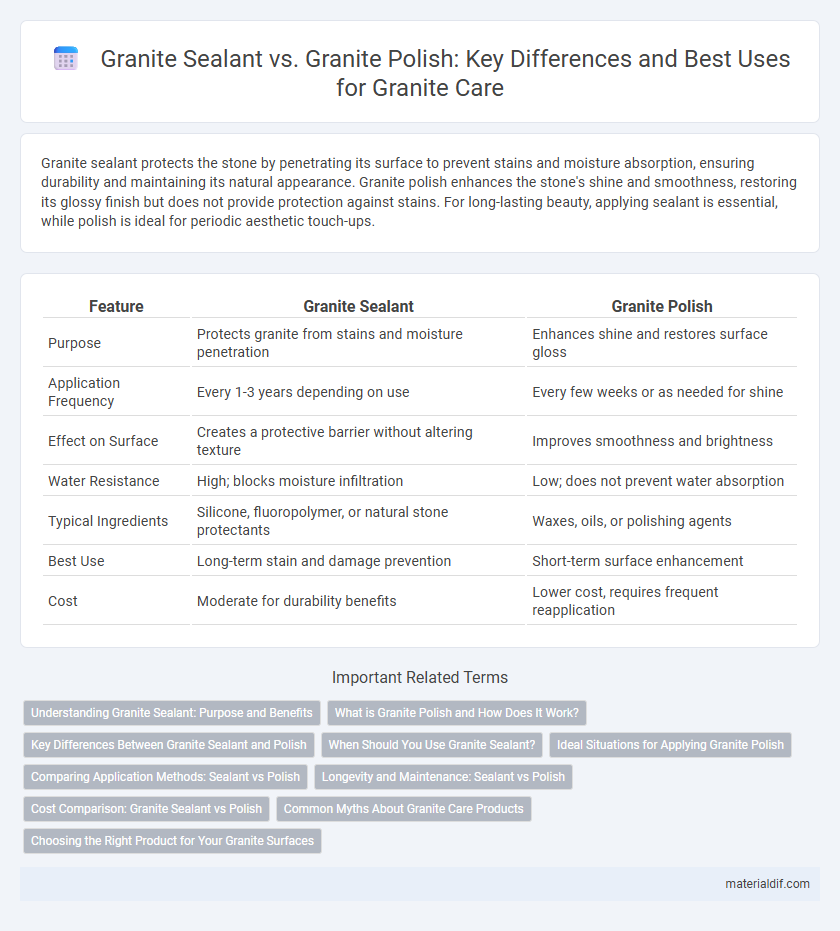Granite sealant protects the stone by penetrating its surface to prevent stains and moisture absorption, ensuring durability and maintaining its natural appearance. Granite polish enhances the stone's shine and smoothness, restoring its glossy finish but does not provide protection against stains. For long-lasting beauty, applying sealant is essential, while polish is ideal for periodic aesthetic touch-ups.
Table of Comparison
| Feature | Granite Sealant | Granite Polish |
|---|---|---|
| Purpose | Protects granite from stains and moisture penetration | Enhances shine and restores surface gloss |
| Application Frequency | Every 1-3 years depending on use | Every few weeks or as needed for shine |
| Effect on Surface | Creates a protective barrier without altering texture | Improves smoothness and brightness |
| Water Resistance | High; blocks moisture infiltration | Low; does not prevent water absorption |
| Typical Ingredients | Silicone, fluoropolymer, or natural stone protectants | Waxes, oils, or polishing agents |
| Best Use | Long-term stain and damage prevention | Short-term surface enhancement |
| Cost | Moderate for durability benefits | Lower cost, requires frequent reapplication |
Understanding Granite Sealant: Purpose and Benefits
Granite sealant is a penetrating product designed to protect natural stone surfaces by creating a barrier against moisture, stains, and spills, preserving the granite's durability and appearance. Unlike granite polish, which enhances shine and smoothness, sealants maintain the stone's structural integrity and prevent damage from liquids and oils. Applying a high-quality granite sealant extends the lifespan of countertops, floors, and other granite installations by reducing the need for frequent repairs and deep cleaning.
What is Granite Polish and How Does It Work?
Granite polish is a specialized product designed to enhance the shine and smoothness of granite surfaces by filling in microscopic pores and scratches, thereby restoring the natural luster. It works by creating a thin protective layer that reflects light and improves the stone's appearance without altering its structural integrity. Unlike sealants that penetrate and protect against stains, granite polish primarily focuses on aesthetic enhancement and surface smoothness.
Key Differences Between Granite Sealant and Polish
Granite sealant penetrates the stone to provide a protective barrier against moisture, stains, and bacteria, enhancing durability and maintaining surface integrity. Granite polish, on the other hand, is a topical application that enhances the granite's shine and smoothness, boosting its aesthetic appeal without providing significant protection. While sealant preserves granite by sealing its pores, polish improves visual appeal by restoring gloss and reducing surface imperfections.
When Should You Use Granite Sealant?
Granite sealant should be applied when the surface begins to show signs of porosity or absorbs liquids, typically every 1-3 years depending on usage and granite type. It acts as a protective barrier against stains, mold, and moisture, preserving the stone's durability and appearance. Regular sealing is essential for maintaining granite countertops, floors, and outdoor stone features exposed to weather.
Ideal Situations for Applying Granite Polish
Granite polish is ideal for enhancing the natural shine and smoothness of granite surfaces that are already sealed and in good condition, providing a glossy, protective finish without altering the stone's structural integrity. It works best on countertops, floors, and bathroom vanities where routine maintenance aims to restore brilliance and minimize minor scratches or dullness. Polishing should be applied in situations where the granite's sealant is intact, as it does not offer the same protective barrier against stains or moisture as a granite sealant.
Comparing Application Methods: Sealant vs Polish
Granite sealant is typically applied using a clean cloth or brush to penetrate and protect the stone's pores, requiring thorough coverage and drying time for effective waterproofing. Granite polish involves buffing the surface with a soft cloth or polisher to enhance shine and smoothness, focusing on surface aesthetics without altering the stone's protective barrier. Sealants provide long-term stain resistance by creating a protective layer, whereas polishes temporarily restore luster but do not offer significant protection against damage or staining.
Longevity and Maintenance: Sealant vs Polish
Granite sealant provides a durable protective barrier that enhances the stone's resistance to stains and moisture, typically lasting 1 to 3 years depending on usage and sealant quality. Granite polish improves surface shine and smoothness but does not offer significant protection against spills or wear, requiring more frequent reapplication to maintain its appearance. For long-term maintenance, applying a high-quality sealant ensures greater longevity and easier cleaning compared to relying solely on polish.
Cost Comparison: Granite Sealant vs Polish
Granite sealant typically costs between $30 and $60 per gallon, requiring application every 1 to 3 years to maintain protection. Granite polish, priced around $10 to $25 per bottle, focuses on enhancing shine but offers no long-term surface protection. Choosing between sealant and polish depends on budget priorities, where sealant offers durable protection at a higher initial cost, and polish provides a lower-cost option for aesthetic improvement.
Common Myths About Granite Care Products
Granite sealant and granite polish serve distinct purposes, yet common myths often confuse their functions, such as believing sealants add shine or polishes protect against stains. Granite sealants penetrate the stone to provide a protective barrier against moisture and stains, while granite polishes enhance the surface's luster without offering waterproofing. Proper care involves using sealants to maintain durability and polishes sparingly for aesthetic enhancement, debunking misconceptions that one product can fulfill all maintenance needs.
Choosing the Right Product for Your Granite Surfaces
Granite sealant penetrates the stone to create a protective barrier against moisture, stains, and damage, making it essential for preserving durability and longevity. Granite polish enhances the surface shine by filling microscopic pores and restoring luster but does not offer significant protection against staining or etching. Choosing the right product depends on whether you need to protect your granite from daily wear and spills or simply want to enhance its appearance.
Granite Sealant vs Granite Polish Infographic

 materialdif.com
materialdif.com